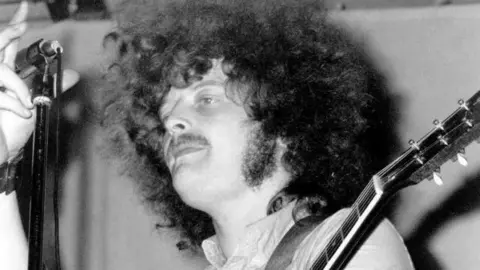-
Posts
15887 -
Joined
-
Last visited
Content Type
Profiles
Forums
Store
Downloads
Recruiting - 2020
2019-2020 Football Season
Football
Entertainment
Sports
News and Business
Cloak Room
Transfer Portal
Recruiting
Events
Posts posted by Bevo
-
-
Emeril Lagasse 66
Martina Navratilova 69
Sinbad 69
Nick Nolte 84
Sandy Koufax 89
Tom Arnold 66
Ron Jeremy 72
Ed Jones 74
Gucci Mane 45
Christina Applegate 54
-
Jethro Tull founding member dies aged 82
2 hours agoNeve Gordon-Farleigh Getty Images
Mick Abrahams starred on Jethro Tull's debut album, This Way, released in 1968
Getty Images
Mick Abrahams starred on Jethro Tull's debut album, This Way, released in 1968Mick Abrahams, a founding member of rock band Jethro Tull, has died at the age of 82.
Posting on the band's official website, lead singer Ian Anderson said he was sorry to hear of the death of the "strong vocalist and experienced, powerful and lyrical guitarist".
He said Luton-born Abrahams had "endured worsening ill health for the last 15 years, leaving him finally unable to perform".
Anderson said Abrahams was "vitally important" to the band's early line-up and developed his musical ideas into a "tour de force display of his instrumental talents for the rest of his performing days".
Jethro Tull were formed "out of the ashes" of The John Evan Band and McGregor's Engine, the blues band Abrahams formed with Clive Bunker in the Luton/Dunstable area, said Anderson.
Abrahams played on Tull's first album, This Was, but left shortly after it was finished, and went on to found another successful band, Blodwyn Pig.
After pursuing a solo career between 1971 and 2017, he retired from performing following a stroke.
Anderson described him as a "homebody" who "liked to gig around the home counties".
He said: "We all offer our condolences to Mick's family and close friends, who can feel justifiably proud of his achievements and musical legacy."
-
 2
2
-
 4
4
-
-
https://www.newsweek.com/russia-ukraine-war-zelensky-putin-attack-update-11258377
Russia-Ukraine War: Zelensky Issues Fresh Putin Demand After Massive Attack
Published
Dec 23, 2025 at 03:45 AM EST
updated
Dec 23, 2025 at 03:59 AM EST
Shane Croucher
By Shane CroucherBreaking News Editor
Newsweek is a Trust Project memberUkrainian President Volodymyr Zelensky told the world it must apply more pressure on Russian President Vladimir Putin to end the war after he said Moscow's forces had launched a "massive" overnight attack into Tuesday with hundreds of drones and dozens of missiles, causing at least three deaths, including a little girl.
"This Russian strike sends an extremely clear signal about Russia’s priorities. A strike ahead of Christmas, when people want simply to be with their families, at home, in safety," Zelensky said in a post on Telegram, originally in Ukrainian.
"A strike carried out virtually in the midst of negotiations aimed at ending this war. Putin cannot accept the need to stop killing. And this means the world is not applying enough pressure on Russia. Action is needed now. Russia must be forced toward peace and guaranteed security."
A woman died in the Kyiv region and another person in Khmelnytskyi. A four-year-old girl died in Zhytomyr when a residential building was struck by a drone.
Zelensky said the strike hit energy and civilian infrastructure. He had earlier proposed a Christmas truce on energy strikes to shield civilians on either side from blackouts and unheated homes during the bitter winter months, which Russia rejected.
The Kremlin has repeatedly ruled out temporary ceasefires, saying Ukraine would use a pause to regroup and rearm while it is losing on the battlefield. Instead, Russia says it wants a peace agreement that ends the fighting to be comprehensive and permanent.
During the latest Russian attack on Ukraine, neighboring NATO ally Poland scrambled fighter jets. Poland also put ground-based air defense and radar reconnaissance systems on "the highest state of readiness" to protect NATO territory, Warsaw's military said. Earlier in the year, Poland shot down what it said were Russian drones violating its airspace.
-
 3
3
-
-
4 minutes ago, Atticus said:
Arkansas was one of the worst defenses in the country. Gotta see how he graded out and scout him closely after being part of that abysmal unit.
True but we have a need for situational players as well. He could be a good goalline player.
-
 1
1
-
-
5 minutes ago, Park Gothic said:
Smoke on this guy. There's the Orphey connection and OTF just did a video on him/
they have a very good young receiver also -
- Popular Post
- Popular Post
28 minutes ago, MuellerHorn said:For a guy like DeAndre Moore, he was a lead-by-example guy. Moore came in every day with the idea to be the first on the field for practice and to win his job by hard work and attention to detail. He did exactly that.

-
 1
1
-
 9
9
-
19 minutes ago, MichaelDicksonFanClub said:
Very productive ILB
-
58 minutes ago, texifornia said:
That hindsight sure is crystal clear!
Shit, I don’t even know if that’s true. But, it sure would have been nice to know before the season that there were more pressing needs that required funding and there was no need to kiss that chump’s ass.
-
We would have been better off if we had let him walk after the playoffs and used the money on a starter level left guard.
-
 2
2
-
-
Moscow probes Kyiv link after bomb kills general
Russian general killed in car bomb in Moscow
04:50Russian general killed in suspected car bomb in Moscow
By Virginia Pietromarchi
Published On 22 Dec 202522 Dec 2025Al Jazeera
Russian authorities say a car bomb explosion in southern Moscow has killed Lieutenant General Fanil Sarvarov.
Investigators say they are pursuing various lines of inquiry, including the possibility the attack was “linked” to “Ukrainian special forces”.
A Ukrainian drone attack damaged two vessels, two piers, and sparked a fire in a village on the Black Sea coast in Russia’s Krasnodar region, according to regional authorities.-
 4
4
-
 2
2
-
 1
1
-
 1
1
-
-
1 hour ago, Sgt Hulk said:
Plus he sucks and OU sucks
He should probably stay as it seems like a good match.
-
 2
2
-
 1
1
-
-
12 minutes ago, UDontKnow said:
This might very well be a legit option. He also has ties to Texas from time spent in community college.
https://astateredwolves.com/sports/football/roster/tristian-smith/7497
Yeah, I don't know anything about him but he has the requisite size - Big step up in competition, but...
-
3 hours ago, TOR said:
That previous topic title, seriously aggy? Lamar is a legit 6'2" (not 5'10" in heels) and 30lbs heavier. What kind of nonsense is this.
He was referring to Hedley Lamarr.
-
 2
2
-
-
On 12/18/2025 at 10:17 AM, Foosters said:
Fair points, and because the Democratic party did not open up the nomination process, we had to vote for the guy who spent 3 months trying to overturn a free and fair election and install himself as the unelected leader of the country.
Good point - What the fuck is going on with Georgia now?
-
 1
1
-
-
2 minutes ago, DaysOff said:
Paul can't read music.But, he sure can tell a good story.
-
Stream?
-
54 minutes ago, Born to Run said:
And then they will be hungry a few hours later anyway. Amirite?
It's all that MSG
-
 1
1
-
-
When are we getting Lee?
-
 2
2
-
-
29 minutes ago, WBT said:
NS wins again
Yay Houston!
-
26 minutes ago, Irish Wrist Watch said:
I predict that they'll change the selection rules for next year. You heard it here first.
Well, they can’t keep a 3 loss tOSU out. They had a tough schedule. -
I have a degree from Tulane and still can’t watch the game.
-
 2
2
-
-
1 hour ago, William Bludworth said:
Gut your staff and start over on different position groups? If he keeps Flood it's all for naught.
Flood is a decent field coach. I wonder if a good portion of his problem is his lack of ability to convince Sark and Banks that he needs more NIL. His inability to recognize his interior line deficiencies is unforgivable, however. -
Just to clarify:
Hoo-hoo-hoo
Go on, take the money and run -
Just now, Laxtonto said:
Kid I get it, your young, I know he's a freshman... but you need to go to the Crash Davis school of platitudes for interviews...
FIFY - Kid, I get it. You're young, but you need to go to the Crash Davis School of Platitudes for interviews.




2026 Celebrity Death Watch Pool
in Daily Texan
Posted
As is true for most 60 year old dicks.